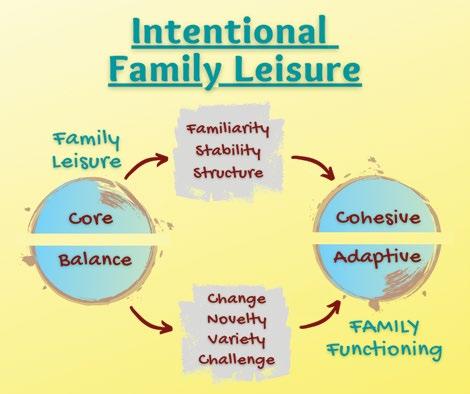
3 minute read
A Family That Plays Together Stays Together
By Rob Henderson, LASUDC, CTRS
“A family that plays together stays together” is more than just a fun phrase or a catchy recreation center slogan. Research tells us that the healthiest families and couples are those who prioritize and are intentional with their leisure time together, a fact that may be surprising to some. Sounds like we better consider dusting off our play-books.
To become better play-makers in our families, we first need to remind ourselves what it means to be intentional. American families are actually around each other quite a bit. The problem is we’ve become so digitized that we’re spending more time than ever “alone together.” Our family units tend to be close in proximity, but we have fewer interpersonal connections as we watch TV or eat our meals on the go among cellphone-illuminated faces.
It’s not that “alone together” is bad per se, but it’s not as good as it could be either. Just as a steady diet of eating only rice for our meals or walking around the block a few times a week to be active will maintain a certain level of health, certain levels of family wellness are maintained just by being around one another. But aren’t we looking for more than just survival in our families? Don’t we want our relationships to thrive with hardier and healthier— intentional—experiences? Sign me up!
While the thought of intentionality can sound incredibly exhausting (especially in light of my last article about time poverty in America), it doesn’t have to be a struggle. Researchers have simplified some of this for us by identifying two types of family leisure that we should focus on with our families. They are:
• Core Family Leisure. This usually takes place inside the home or close by in the community. Core activities should be easily accessible and take minimal preparation, planning, travel time, and cost. The important thing is that the family is engaged together. Cooking, riding bikes, playing board or video games, working on house projects, sharing hobbies, or enjoying a neighborly BBQ are all examples of core play. Informal activities and sports in the yard, at the park, or at a community or recreation center are also examples.
• Balance Family Leisure. This type of family activity is more involved. Balance activities usually require planning, travel away from home, and sometimes even training. They tend to be outside of a family’s routine and comfort zone. Examples of balance activities include family road trips, vacations, and retreats, like visiting a national park, camping, going to a concert or an amusement park, and visiting friends or family you may not see often. Balance experiences are less frequent and usually more work, but they are also much richer in novelty and reward.
As explained in the graphic below, little core shifts in the way we play together foster stability, familiarity, and structure, ultimately creating a more cohesive family. And following through with those bigger balance adventures introduces change, novelty, variety, and challenge, leading our families to become more adaptable.
I guess it’s time to say, “Alexa, add ‘core and balance activities’ to our play-list!”












